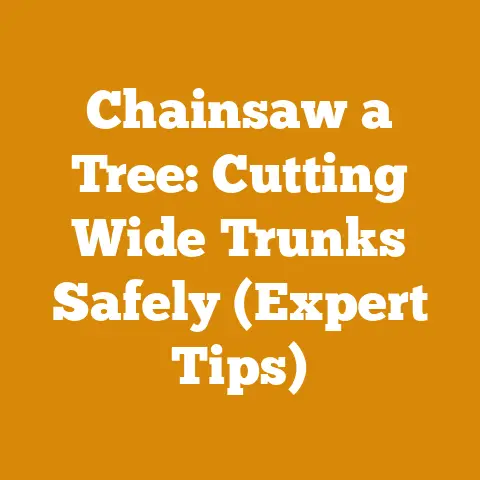Chainsaw Wont Stay Running (5 Pro Tips to Fix Hot Cutting Issues)
Ah, the warmth of a wood-burning stove on a cold winter’s night. There’s simply nothing like it. I’ve spent a good chunk of my life around wood, from felling towering trees in the Pacific Northwest to meticulously splitting firewood for my own home. And let me tell you, there’s nothing more frustrating than a chainsaw that decides to quit right in the middle of a big cut, especially when you’re battling a pile of timber on a hot summer day.
A chainsaw that won’t stay running, particularly when it’s hot, is a common problem that plagues both weekend warriors and seasoned professionals. It’s not just annoying; it can be a safety hazard and a real time-killer. Imagine you’re deep in the woods, far from your truck, and your saw decides to die on you. Suddenly, a simple firewood-gathering trip turns into a survival situation.
Over the years, I’ve learned that “hot cutting issues” – when a chainsaw stalls or refuses to start after it warms up – usually stem from a handful of culprits. These issues can range from simple fixes to more complex problems requiring a deeper understanding of chainsaw mechanics. In this guide, I’ll share my top 5 pro tips to diagnose and fix a chainsaw that won’t stay running when it’s hot. I’ll break down the complexities of chainsaw maintenance into understandable steps, ensuring that anyone, from a complete beginner to an experienced user, can tackle these common problems.
This guide is designed for anyone who uses a chainsaw, whether you’re a homeowner preparing for winter, a small-scale logging business owner, or a hobbyist woodworker. I’ll cover the essential aspects of chainsaw maintenance, focusing on practical solutions that you can implement immediately. We’ll talk about tools, materials, techniques, and, most importantly, safety.
Let’s dive in and get your chainsaw running smoothly, no matter how hot the work gets.
Chainsaw Won’t Stay Running: 5 Pro Tips to Fix Hot Cutting Issues
1. Fuel System Follies: Vapor Lock, Fuel Lines, and Carburetor Conundrums
The fuel system is the lifeblood of your chainsaw. Just like a car, your saw needs a consistent and clean supply of fuel to run properly. When a chainsaw won’t stay running, especially when it’s hot, the fuel system is often the first place I look.
Vapor Lock: The Invisible Enemy
Vapor lock occurs when the fuel in your chainsaw’s fuel line gets too hot and vaporizes. This creates bubbles in the fuel line, preventing liquid fuel from reaching the carburetor. Think of it like trying to drink through a straw filled with air bubbles.
- Why it happens: High temperatures, combined with the heat generated by the engine, can cause the fuel to vaporize prematurely. This is especially common in older chainsaws or those with poor ventilation.
- Diagnosis: If your chainsaw starts fine when cold but stalls shortly after warming up and then refuses to restart until it cools down, vapor lock is a likely culprit.
-
Solution:
- Use fresh fuel: Old fuel can be more prone to vaporization. I always recommend using fuel that’s less than 30 days old and stored in a cool, dark place.
- Fuel Stabilizer: If you are not going to use all the fuel in a month, add a fuel stabilizer. This will help prevent the fuel from going bad and causing problems.
- Improve ventilation: Ensure your chainsaw’s cooling fins are clean and free of debris (more on this in Tip #4). Good airflow helps dissipate heat and prevent fuel from overheating.
- Wrap fuel lines: In extreme cases, you can wrap the fuel lines with heat-reflective tape to shield them from engine heat.
- Let it cool: The simplest fix is often the best. If you suspect vapor lock, let the chainsaw cool down completely before attempting to restart it. This allows the fuel to return to its liquid state.
Fuel Lines: The Silent Saboteurs
Fuel lines are the small rubber or plastic tubes that carry fuel from the tank to the carburetor. Over time, these lines can crack, become brittle, or even collapse, restricting fuel flow.
- Why it happens: Exposure to fuel, heat, and UV radiation can degrade fuel lines over time.
- Diagnosis: Inspect the fuel lines for cracks, leaks, or kinks. A common sign is a chainsaw that starts and runs briefly but then stalls. You might also notice fuel leaking around the fuel lines.
-
Solution:
- Visual inspection: Carefully examine the fuel lines for any signs of damage. Pay close attention to the areas where the lines connect to the fuel tank and carburetor.
- Replacement: Replacing fuel lines is a relatively inexpensive and straightforward repair. I recommend using fuel lines specifically designed for chainsaws, as they are more resistant to fuel and heat. A typical chainsaw fuel line kit costs around $10-$20.
- Fuel Filter: While you’re replacing the fuel lines, it’s always a good idea to replace the fuel filter as well. A clogged filter can restrict fuel flow and cause similar symptoms to faulty fuel lines. Fuel filters usually cost around $5-$10.
Carburetor Cleaning and Adjustment: The Fine-Tuning Process
The carburetor is responsible for mixing fuel and air in the correct ratio for combustion. A dirty or improperly adjusted carburetor can cause a variety of problems, including stalling, poor performance, and difficulty starting.
- Why it happens: Over time, the carburetor can become clogged with dirt, debris, and fuel residue. Improper adjustment can also throw off the fuel-air mixture.
-
Diagnosis: Signs of a carburetor problem include:
- Difficulty starting the chainsaw
- Rough idling or stalling
- Poor acceleration
- Black smoke from the exhaust (too much fuel)
- White smoke from the exhaust (too little fuel)
-
Solution:
-
Carburetor Cleaning: I’ve cleaned countless carburetors over the years. The key is to be thorough and patient. Disassemble the carburetor carefully, taking note of the location of each part. Use carburetor cleaner to remove any dirt or debris. Pay special attention to the jets and passages, as these are most prone to clogging. A can of carburetor cleaner typically costs around $5-$10.
-
Carburetor Adjustment: Most chainsaws have three adjustment screws on the carburetor:
- L (Low speed): Adjusts the fuel-air mixture at idle.
- H (High speed): Adjusts the fuel-air mixture at full throttle.
- LA (Idle speed): Adjusts the engine speed at idle.
The proper adjustment procedure varies depending on the chainsaw model, so consult your owner’s manual. As a general rule, start by turning both the L and H screws all the way in and then backing them out 1 to 1.5 turns. Fine-tune the screws until the chainsaw idles smoothly and accelerates without hesitation. I find that a small tachometer ($20-$30) is invaluable for setting the idle speed correctly. Typically, the idle speed should be around 2,700-3,000 RPM. * Carburetor Rebuild: In some cases, the carburetor may be too damaged or worn to be cleaned effectively. A carburetor rebuild kit contains replacement parts, such as gaskets, diaphragms, and needles, which can restore the carburetor to like-new condition. Rebuild kits typically cost around $20-$40.
My Experience: I once had a Stihl MS 290 that would start fine but stall after a few minutes of cutting. After checking the fuel lines and spark plug, I decided to clean the carburetor. I carefully disassembled it, soaked it in carburetor cleaner, and reassembled it. The chainsaw ran perfectly afterward. It was a simple fix that saved me a lot of time and money.
2. Ignition System Insights: Spark Plugs, Coils, and Kill Switches
The ignition system is responsible for creating the spark that ignites the fuel-air mixture in the cylinder. If the ignition system is faulty, the chainsaw won’t start or run properly.
Spark Plugs: The Spark of Life
The spark plug is a crucial component of the ignition system. A fouled, worn, or improperly gapped spark plug can prevent the chainsaw from starting or running smoothly.
- Why it happens: Over time, the spark plug electrodes can wear down, become coated with carbon deposits, or crack.
-
Diagnosis:
- Visual inspection: Remove the spark plug and inspect it for signs of damage or wear. A healthy spark plug should have clean, dry electrodes with a light tan or gray color. Black, oily, or wet electrodes indicate a problem.
- Spark test: Remove the spark plug, reattach it to the spark plug wire, and ground the spark plug against the engine block. Pull the starter cord. You should see a strong, blue spark jump across the electrodes. If the spark is weak, intermittent, or nonexistent, the spark plug is likely faulty.
-
Solution:
-
Cleaning: If the spark plug is fouled with carbon deposits, you can try cleaning it with a wire brush or spark plug cleaner. However, if the spark plug is worn or damaged, it’s best to replace it.
- Gapping: The spark plug gap is the distance between the electrodes. The proper gap varies depending on the chainsaw model, so consult your owner’s manual. A typical spark plug gap is around 0.025-0.030 inches (0.6-0.8 mm). Use a spark plug gapping tool to adjust the gap to the correct specification.
- Replacement: Spark plugs are relatively inexpensive and easy to replace. I recommend replacing the spark plug every year or after every 100 hours of use. A new spark plug typically costs around $5-$10.
Ignition Coil: The Power Source
The ignition coil is responsible for generating the high-voltage electricity that creates the spark at the spark plug. A faulty ignition coil can prevent the chainsaw from starting or running.
- Why it happens: Ignition coils can fail due to heat, vibration, or electrical damage.
-
Diagnosis:
- Spark test: If the spark plug is good but you’re still not getting a spark, the ignition coil is a likely culprit.
- Resistance test: Use a multimeter to measure the resistance of the ignition coil. The resistance should fall within the range specified in your owner’s manual. If the resistance is outside of this range, the ignition coil is faulty.
- Solution: Replacing the ignition coil is a more complex repair that may require some mechanical experience. Ignition coils typically cost around $20-$50.
Kill Switch: The Safety Override
The kill switch is a safety device that allows you to quickly shut off the engine. A faulty kill switch can prevent the chainsaw from starting or running.
- Why it happens: Kill switches can become corroded, damaged, or stuck in the “off” position.
- Diagnosis: Disconnect the kill switch wire from the ignition coil. If the chainsaw starts and runs, the kill switch is faulty.
- Solution: Replacing the kill switch is a simple repair that usually involves removing a few screws and disconnecting the wires. Kill switches typically cost around $10-$20.
Case Study: I once worked on a Husqvarna 455 Rancher that would start and run for a few minutes but then stall. I checked the fuel system and found no problems. I then checked the spark plug and found that it was heavily fouled with carbon deposits. I cleaned the spark plug and reinstalled it, but the chainsaw still stalled. I then decided to replace the spark plug with a new one. The chainsaw ran perfectly afterward. The old spark plug was simply too worn to provide a consistent spark.
3. Airflow Assurance: Air Filters and Cooling Fins
A chainsaw engine needs a constant supply of clean air to run efficiently. A clogged air filter or blocked cooling fins can restrict airflow, causing the engine to overheat and stall.
Air Filters: The Breath of Fresh Air
The air filter prevents dirt and debris from entering the engine. A clogged air filter restricts airflow, causing the engine to run rich (too much fuel) and overheat.
- Why it happens: Air filters become clogged with dust, sawdust, and other debris over time.
-
Diagnosis:
- Visual inspection: Remove the air filter and inspect it for dirt and debris. A dirty air filter will be visibly clogged.
- Performance: A chainsaw with a clogged air filter may be difficult to start, run poorly, or stall frequently.
-
Solution:
-
Cleaning: Clean the air filter regularly with compressed air or warm, soapy water. Allow the air filter to dry completely before reinstalling it.
- Replacement: Replace the air filter every year or after every 50 hours of use. Air filters typically cost around $5-$15.
- Type of Air Filter: There are generally two types of air filters: foam and felt. Foam filters can be washed multiple times. Felt filters are generally replaced.
Cooling Fins: The Heat Dissipaters
The cooling fins are metal fins on the engine that help dissipate heat. Blocked cooling fins prevent the engine from cooling properly, causing it to overheat and stall.
- Why it happens: Cooling fins become blocked with sawdust, dirt, and debris over time.
-
Diagnosis:
- Visual inspection: Inspect the cooling fins for dirt and debris. The cooling fins are typically located around the cylinder and cylinder head.
- Overheating: A chainsaw with blocked cooling fins will overheat quickly and may stall frequently.
-
Solution:
-
Cleaning: Clean the cooling fins regularly with a brush or compressed air. Pay special attention to the areas around the cylinder and cylinder head.
- Frequency: How often you should clean the cooling fins depends on how often you use the chainsaw. If you use the chainsaw daily, you should clean the cooling fins at least once a week. If you only use the chainsaw occasionally, you should clean the cooling fins after each use.
Personal Experience: I remember one summer working on a large firewood project. My chainsaw kept overheating and stalling, even after cleaning the air filter. I finally took a closer look and realized that the cooling fins were completely packed with sawdust. After cleaning the cooling fins, the chainsaw ran like new.
4. Exhaust Examination: Mufflers and Spark Arrestors
The exhaust system is responsible for removing exhaust gases from the engine. A clogged muffler or spark arrestor can restrict exhaust flow, causing the engine to overheat and stall.
Mufflers: The Noise Reducers
The muffler reduces the noise produced by the engine. A clogged muffler restricts exhaust flow, causing the engine to run poorly and overheat.
- Why it happens: Mufflers become clogged with carbon deposits over time.
-
Diagnosis:
- Visual inspection: Inspect the muffler for carbon deposits.
- Performance: A chainsaw with a clogged muffler may be difficult to start, run poorly, or stall frequently.
-
Solution:
-
Cleaning: Clean the muffler regularly with a wire brush or carburetor cleaner. In severe cases, you may need to remove the muffler and soak it in carburetor cleaner overnight.
- Replacement: If the muffler is severely clogged or damaged, it may need to be replaced. Mufflers typically cost around $20-$50.
Spark Arrestors: The Fire Preventers
The spark arrestor prevents sparks from exiting the exhaust system, reducing the risk of fire. A clogged spark arrestor restricts exhaust flow, causing the engine to run poorly and overheat.
- Why it happens: Spark arrestors become clogged with carbon deposits over time.
-
Diagnosis:
- Visual inspection: Remove the spark arrestor and inspect it for carbon deposits.
- Performance: A chainsaw with a clogged spark arrestor may be difficult to start, run poorly, or stall frequently.
-
Solution:
-
Cleaning: Clean the spark arrestor regularly with a wire brush. In severe cases, you may need to soak the spark arrestor in carburetor cleaner overnight.
- Replacement: If the spark arrestor is severely clogged or damaged, it may need to be replaced. Spark arrestors typically cost around $5-$15.
Real World Example: I once worked on a job site where a chainsaw started a small brush fire. After investigating, I discovered that the spark arrestor was missing. I always make sure that my chainsaws have a functioning spark arrestor, especially when working in dry conditions.
5. Overheating Overview: Engine Stress and Prevention
Even with all the preventative measures in place, your chainsaw can still overheat. Understanding the causes of overheating and how to prevent it is crucial for maintaining your saw’s performance and extending its lifespan.
Causes of Overheating:
- Prolonged Use: Continuous use, especially in hot weather, can cause the engine to overheat.
- Dull Chain: A dull chain forces you to apply more pressure, which puts extra strain on the engine and generates more heat.
- Improper Fuel Mixture: Using the wrong fuel mixture (too much oil) can cause the engine to run hotter than normal.
- Heavy Cutting: Cutting large, dense logs requires more power and generates more heat.
Prevention Strategies:
- Take Breaks: Allow the chainsaw to cool down periodically, especially during prolonged use. I typically take a 15-minute break every hour.
- Sharpen Your Chain: Keep your chain sharp to reduce the amount of effort required to cut through wood. A sharp chain cuts more efficiently and generates less heat. I use a chainsaw file kit ($20-$30) to sharpen my chains regularly.
- Use the Correct Fuel Mixture: Always use the fuel mixture recommended by the manufacturer. Typically, this is a 50:1 ratio of gasoline to oil.
- Avoid Heavy Cutting: If possible, avoid cutting large, dense logs in hot weather. If you must cut large logs, take breaks frequently and allow the chainsaw to cool down.
- Use Synthetic Oil: Synthetic oil provides better lubrication and can help reduce engine heat. I prefer using synthetic oil in my chainsaws.
- Check the Engine Temperature: If you suspect that your chainsaw is overheating, you can use an infrared thermometer ($20-$40) to check the engine temperature. The engine temperature should not exceed the manufacturer’s recommended limit.
Case Study: I once had a client who complained that their chainsaw kept overheating and stalling. After inspecting the chainsaw, I discovered that they were using a dull chain and cutting large, dense logs in hot weather. I sharpened the chain, recommended that they take breaks frequently, and advised them to avoid cutting large logs in hot weather. The client followed my advice, and their chainsaw no longer overheated.
Strategic Insight: Preventing overheating is not just about maintaining your chainsaw; it’s also about safety. An overheated chainsaw can be a fire hazard, and it can also be more likely to malfunction, potentially causing injury.
Final Thoughts:
Fixing a chainsaw that won’t stay running when hot requires a systematic approach. By understanding the fuel system, ignition system, airflow, exhaust system, and overheating prevention, you can diagnose and fix most common problems. Remember to always prioritize safety and consult your owner’s manual for specific instructions.
Next Steps:
- Review Your Owner’s Manual: Familiarize yourself with the specific maintenance procedures for your chainsaw model.
- Gather Your Tools: Assemble the necessary tools, such as screwdrivers, wrenches, spark plug socket, carburetor cleaner, and compressed air.
- Start with the Basics: Begin by checking the fuel, air filter, and spark plug.
- Follow the Troubleshooting Steps: If the basic checks don’t solve the problem, follow the troubleshooting steps outlined in this guide.
- Seek Professional Help: If you’re unable to diagnose or fix the problem, consult a qualified chainsaw mechanic.
By following these tips, you can keep your chainsaw running smoothly and safely for years to come. Happy cutting!






